A testament to decency in human relations
“i carry your heart(i carry it in my heart)” —E.E. Cummings
The Woodmere Art Museum’s A More Perfect Union? Power, Sex and Race in the Representation of Couples traces the evolution of intimate relationships in the United States over the last two hundred-plus years as portrayed by Philadelphia area artists, and does so forthrightly, and with boldness. Among other things, as noted by Bill Valerio, Woodmere’s director, the exhibition explores “the drama of love that breaks the rules, transcending tradition and social boundaries.” Power, sex, race, gender, social class–all of these issues, so relevant today, are touched upon in the show.

At its heart, A More Perfect Union? is an historical meditation and a celebration of love between human beings. It is an observance of the many manifestations of love, and the paths upon which love has taken us. It is an observance of romance, intimacy, passion, desire, and connection, and at the same time of loss, suppression, oppression, and disconnection. It is also a celebration of diversity, freedom, and tolerance. But above all, the exhibition is a moving testament to decency in human relations, and, aptly, it comes at a time in our social and political life when decency itself is under attack.
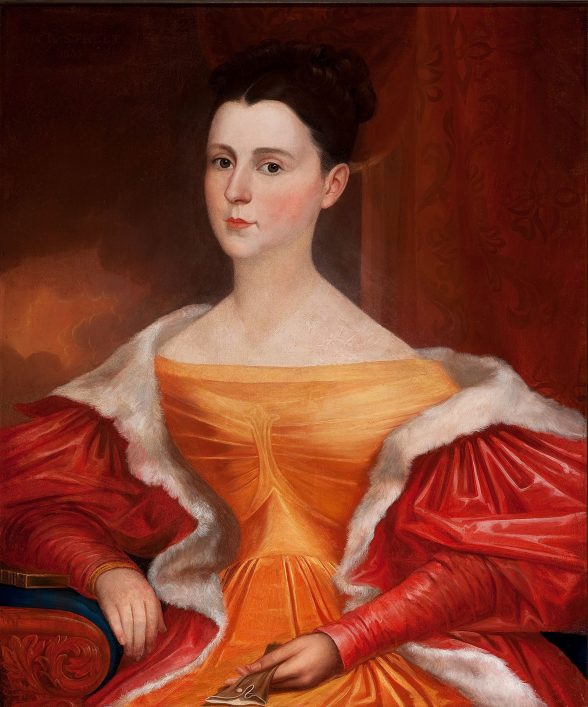
From staid portraiture to the risqué
The first works you will encounter in the exhibit are portraits of couples from the 17th and 18th centuries, many by Philadelphia area artists (of Philadelphia area gentry). As you can imagine, they are formal–depicting men and women separately–if not prim and proper. As an example, I’ve included an image of Robert Street’s “Portrait of a Seated Lady” (1833).

But a few steps into the exhibition, you will find yourself in the midst of the revolution that subsequently occurred in society, reflected in art, when you come upon works such as Martha Mayer Erlebacher’s “The Path” (1999) and Sebastian Collett’s “Triad” (2012), images of which are included here, and which loudly speak for themselves about the emergence of interracial, even triadic intimate relationships.
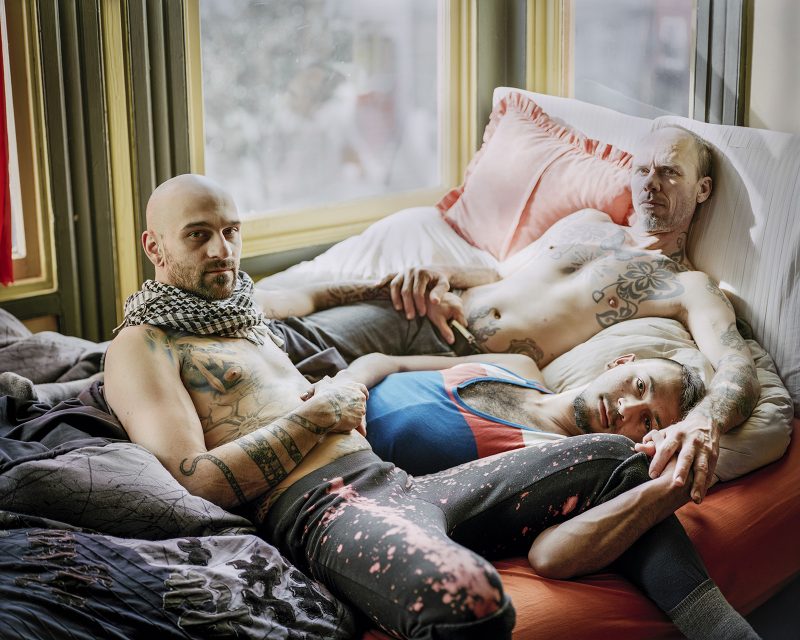
Picturing same-sex love
And along the way, you will encounter works such as anonymous portraits of gay couples from the late 19th century and early 20th century, couples who were rarely able to express their love openly during those periods. As examples, I’ve included here images of an unknown artist’s early 20th century carte-de-visite–from a so-called “Boston marriage” (a term used during that period to refer to two single women living together, independent of men)–entitled “Merry Christmas from Fly and Fritz,” and a “photobooth portrait” which I would guess dates from the middle of the 20th century.
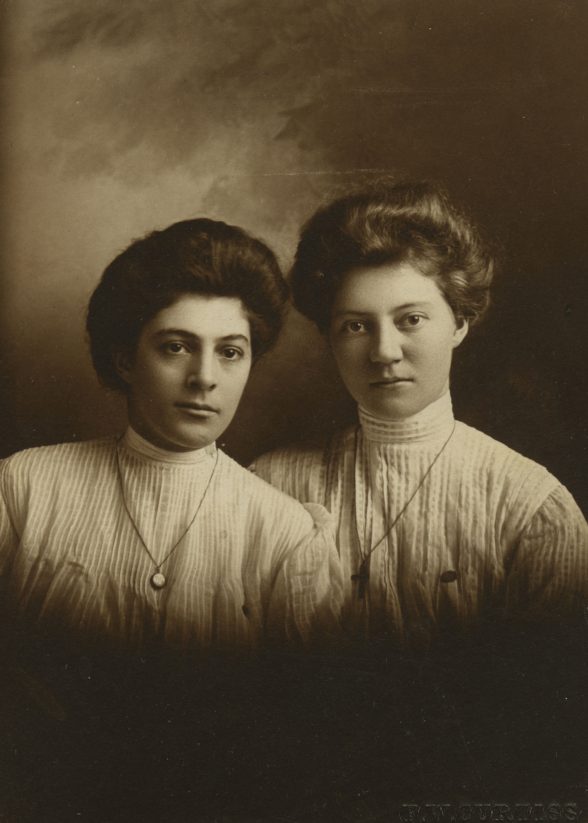
There also are wonderful portraits (not pictured here) of each other by Violet Oakley and Edith Emerson, who figure prominently in Woodmere’s own history; a voluptuous, seductive, nearly-nude woman painted by Ben Kamihira; variations on Adam and Eve by Peter Paone and Jessie Drew-Bear; Christopher Smith’s framed plaster model cast of a nude couple reclining on lounges, from the point of view of their television set (“A View From the Box”); a striking portrait of two preppy, young Hispanic gay men, arm in arm, by Gilbert Lewis, from the 1980s; an intense study of an interracial couple by Donald E. Camp; and there are many, many more which deserve attention, a testament to the depth of this show of more than one hundred pieces.
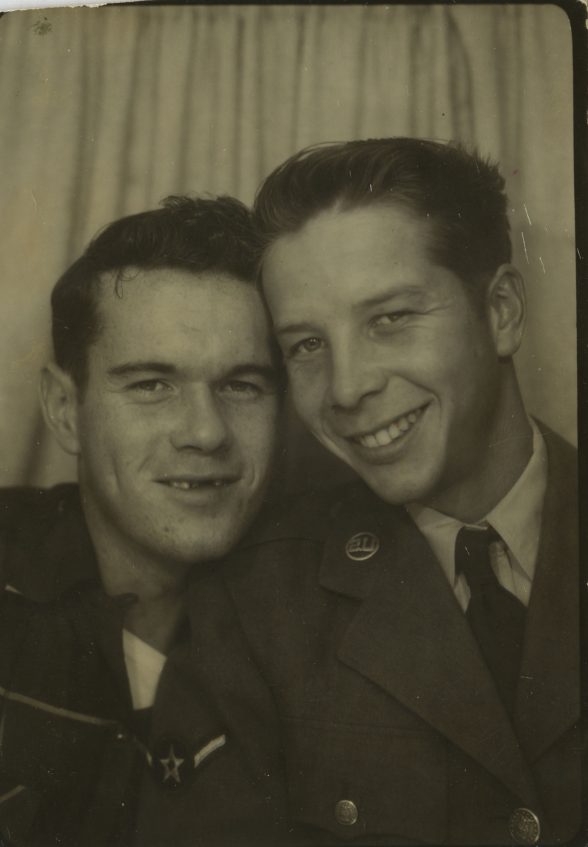
Love, sex, race
Jonathan Lyndon Chase’s “Two Men on Bed” (2015), pictured here, stood out for me. Chase is a young Philadelphian. We interviewed him earlier this year. What struck me in this painting is the gentleness of the exposed figures, their comfort together–their exposed openness. Chase is, perhaps, becoming the Nicole Eisenman of black male gay culture.
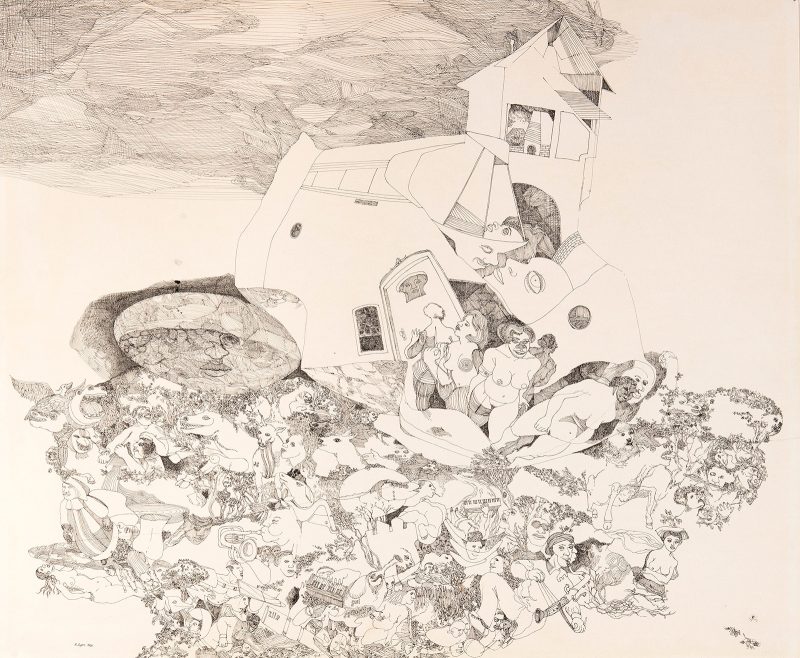
Ronald Ayers’ “Cataclysm, Rebirth New World” (1968) is a dense, intricate drawing of what I took to be a fantastic slave ship, with half-naked black women (some of whom are reduced to creatures) emerging from within. This powerful work by an African American Philadelphian evokes the violence of the slave trade, of slavery, and the victimization, sexually and otherwise, of black women.
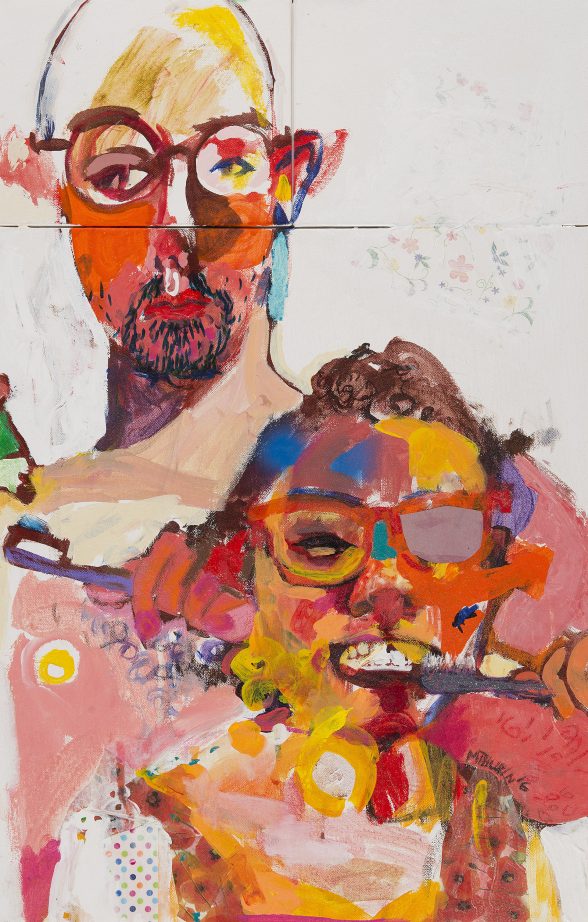
I was also taken by Mickayel Thurin’s “Morning Ritual” (2016). This is a tender portrait of interracial love by another young African American Philadelphian, in the prosaic context of a couple brushing their teeth together in the same mirror.
Images as activism
In the last election, power was vested in politicians and their supporters who are antagonistic to the almost universally accepted fact of more than one sacred form of intimacy between people. Before the election, I might have omitted the question mark from title of the exhibition, which of course borrows words from from the Preamble of the Constitution, because of the many advances that have been achieved, most notably that American humans now do have the legal right to same sex marriage. However, post-election, the title’s question mark seems urgent, reminding us of the shift in power in Washington and the the vulnerability of interpersonal “unions” to whims of politics.
Gabriel Martinez, one of the artists whose work appears in the show, said during a discussion at the museum: “Images are a form of activism.” And yes, this gutsy exhibition–which documents the evolution of intimate relationships in the United States honestly, and without hesitation–is exactly one form of activism that we need very badly at this moment in history, when those in power would turn back the clock on much of the progress that has been made.
I congratulate Bill Valerio and his curatorial team at Woodmere (including Rachel McCay) for the courage and the foresight to mount this important show. Indeed, much of the work that appears in the exhibition comes from Woodmere’s own collection, and a great deal of it has been acquired under Valerio’s stewardship. The names of the artists are set out below.
A More Perfect Union? Power, Sex and Race in the Representation of Couples will be up at the Woodmere Art Museum through May 21st. Don’t miss this one.
The exhibition includes work by:
Constantin Alajálov | Roger Anliker | Kassem Amoudi | Roland Ayers | Bo Bartlett | Cecilia Beaux | Frank Bramblett | Barbara Bullock | Donald E. Camp | Jonathan Lyndon Chase | Sebastian Collett | Bruce Cratsley | James Cremer | Almitra Marino David | Larry Day | Giuseppe Donato | Jessie Drew-Bear | Kaitlyn Dunphy | Edith Emerson | Martha Mayer Erlebacher | Walter Erlebacher | Emlen Pope Etting | John Falter | William Newport Goodell | Eileen Goodman | Richard Guggenheim | Thomas Hovenden | Frederick James | Alex Kanevsky | Gilbert Lewis | Arlene Love | Samuel Maitin | Gabriel Martinez | Sarah McEneaney | Mitzi Melnicoff | Anne Minich | John W. Mosley | Edith Neff | Violet Oakley | Peter Paone | Charles Willson Peale | Irving Penn | Salvatore Pinto | Norman Rockwell | Peter Frederick Rothermel | Laurence Salzmann | Dick Sargent | Suzanne Schireson | Sterling Shaw | Christopher Smith | Nora Speyer | Benton Spruance | Robert Street | James Stidun | Thomas Sully | Lucia Thomé | Mickayel Thurin | Ellen Powell Tiberino | Rochelle Toner | Bill Walton | Franklin Watkins









